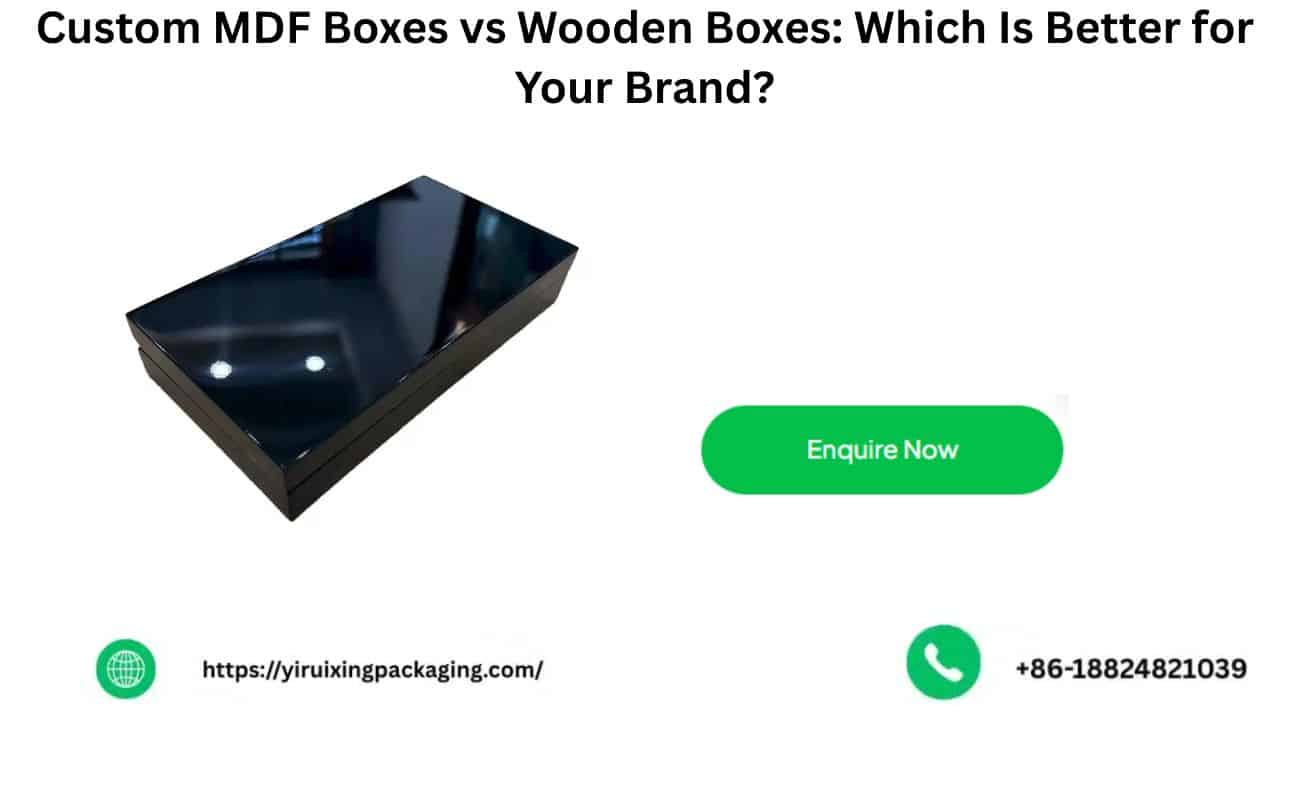Are you searching for the right packaging material that helps in elevating your brand, influencing customer perception, and impacting your bottom line? Don’t worry about it, we provide you with the full details. When it comes to premium packaging, two names are most popular: custom MDF boxes and traditional wooden boxes. Each of them sets its own advantages, drawbacks, and brand implications. Now you are again confused which one is best, no need to worry, here in this blog, we provide you with the difference between Custom MDF boxes vs Wooden boxes and also provide which one is better for your brand.
Table of Contents
ToggleUnderstanding the Materials
What is MDF?
MDF is an artificial wood product made from wood pulp that is processed with glue and wax under very high temperatures. The box made of MDF offers a flat, smooth surface that is free of any knots and natural grain interruptions making it ideal for uniform finishing and then painting, etc.
What are Wooden Boxes (Solid or Engineered Wood)?
Wooden boxes are made out of strong timber or first rate plywood/plank wood. The feature of this box is the natural timber grain, resulting in a strong and steeply-priced influence. For these reasons, boxes are picked for luxury packaging due to their high-end aesthetic appeal accompanied by robustness.
Key Facts to Consider
- MDF boxes are 30 to 40% cheaper than custom wooden boxes in packaging applications
- According to Market Research Intellect, the empty wooden boxes market is projected to grow from USD 1.85 billion in 2024 to USD 3.25 billion by 2033 with a 7.5% CAGR.
- There are 81% of customers prefer eco-friendly packaging materials, and 70% select the product based on packaging sustainability.
- MDF boxes’ structure provides more intricate cuts, designs and also a proper finishing surface as compared to natural wood.
- MDF is less water-resistant and also has lower durability than solid wood in demanding conditions.
Comparison Table: MDF vs Wooden Boxes
Practical Brand‐Decision Criteria
Here are some main questions to ask when selecting between MDF and wood:
- Budget: What is your unit cost for packaging? If the cost factor is the main issue, then go for MDF boxes.
- Brand positioning: Is your target market luxury/heritage/high-ticket items that need packaging to portray outstanding quality? If yes, then probably wood will be the better choice.
- Product value & purpose: If the packaging will be reused or kept (e.g., for jewellery, premium gifts), wood may justify the investment. If it’s more about the immediate unboxing experience, MDF can serve effectively.
- Design/customization needs: If your brand requires complex shapes, engraving, vibrant finishes, MDF shines.
- Sustainability history: Consider procurement certification, traceability of raw materials. Wooden boxes can be very green if the wood is sourced from sustainable forests; If the fibres used are from waste resources, MDGF can also declare environmental friendliness, but emissions of rubber and resin must be controlled.
- Durability and logistics: Can the box withstand rough shipping or moisture? Wood holds up better under heavy or rough use.
- Long-term reuse vs single-use: If you expect packaging to stay in customers’ hands for years, wood’s durability may win.
Conclusion
For a brand collaborating with Yiruixing Packaging for the purpose of packaging, here’s the essence of advice: If your brand is targeting the premium segment but is tight on budget, custom MDF boxes present great value, large personalization and a contemporary look that will not affect the quality negatively. On the contrary, if your brand focuses on a high-heritage image, durability, reuse, and tactile luxury of natural wood, then traditional wooden boxes are a smart investment.
In the end, it’s not a matter of one material being “better” than others but of which one matches your brand story, budget, product value, and customer experience. Yiruixing Packaging is there to assist you in deciding among the two options, assessing the pros and cons in terms of fee, customization selections, and supply-chain implications, so you can choose the packaging that not only aligns with your emblem approach but also does not restrict it.
FAQs
Which type of box is better for luxury product packaging?
If you want a premium, timeless feel like jewellery, perfumers, or a luxury spirit which focuses on your brand, then wooden boxes are the best option. Their natural texture and weight instantly communicate elegance. If your goal is a sleek, contemporary look that is fully customizable, MDF boxes are not only effective but also more affordable.
Are MDF boxes durable enough for premium packaging?
Yes, of course, MDF boxes are durable enough for premium packaging only when they are finished with a protective coating. This box handle is light to use and also great for products where presentation matters more than long-term storage. If you want rugged or moisture-resistant packaging, then solid wood is stronger.
Which option is more eco-friendly — MDF or wood?
Basically, it depends on how the materials are sourced. MDF uses recycled wood fibres and also contains synthetic resins. Solid wood is renewable, particularly if it is FSC or PEFC certified. Both of them are eco-friendly; the only matter is working with a responsible manufacturer like Yiruixing Packaging that follows sustainable practices.
Why are MDF boxes cheaper than wooden boxes?
MDF is an engineered product that can be mass-produced using wood fibres and resin, which are low in raw material costs and ensure uniformity. Wooden boxes require natural lumber and more manual craftsmanship which drives up cost. On average, MDF boxes can be 30 to 40% cheaprs than solid wood boxes.





